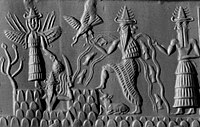ニンシュブル

ニンシュブル(Ninshubur)は、シュメール神話に登場する女神イナンナのスッカル(英語版)(ワズィール)である。ニンシュブルはまた天空の神アンの大臣を務めており、その延長で神々の集会の伝令使としてギリシア神話のヘルメースやイーリスに似ている。彼女の名前はシュメール語で「従者たちの女王」または「スバルトゥ(英語版)の女王」を意味する。
彼女は最初アキルで崇拝されたが、シュメール初期王朝時代(英語版)にはすでに他の都市で崇拝されていた。ラガシュ、ニップル、シュルッパク、ウルクである。ラガシュの多くの国王は彼女を彼ら個人の神とみなした。彼女はより高位の神に求愛することができると信じられていたため、彼女は日常的な宗教で人気があり、彼女の知的な名前やその他の個人的な崇拝に言及する多くの古代の参考資料が知られている。
神話の中で、ニンシュブルはイナンナの多くの最も有名な事績の中で彼女に付き添っている。イナンナが神聖な「メー」を盗んだ後、彼女はイナンナを助けてアプスーからエンキの下僕をやっつけた。別の神話では、イナンナが冥界に閉じ込められた時、ニンシュブルはエンキに彼女の女主人を解放するように頼む。
彼女は他の伝令神と融合し、最も有名なのはイラブラット(英語版)とパプスッカル(英語版)である。紀元前第一千年紀の後半には、後者がアンにおける彼女の主要な召使の役割を取って代わった。当初は女性神と考えられていたが、多くの点でニンシュブルが男性神とされたのは、融合によるものである可能性が高い。
脚注
- ^ Wolkstein & Kramer 1983, p. 92, 193.
参考文献
- Asher-Greve, Julia M.; Westenholz, Joan G. (2013). Goddesses in Context: On Divine Powers, Roles, Relationships and Gender in Mesopotamian Textual and Visual Sources. ISBN 978-3-7278-1738-0. https://www.zora.uzh.ch/id/eprint/135436/1/Asher-Greve_Westenholz_2013_Goddesses_in_Context.pdf
- Beaulieu, Paul-Alain (1992). “Antiquarian Theology in Seleucid Uruk”. Acta Sumerologica 14. https://www.academia.edu/1233691.
- Beckman, Gary (2002). “Babyloniaca Hethitica: The "babilili-Ritual" from Bogazköy (CTH 718”. Recent Developments in Hittite Archaeology and History. Penn State University Press. doi:10.5325/j.ctv1bxh36t.6. https://www.researchgate.net/publication/44963754
- Black, Jeremy; Green, Anthony (1992). Gods, Demons and Symbols of Ancient Mesopotamia: An Illustrated Dictionary. The British Museum Press. ISBN 0-7141-1705-6. https://books.google.com/books?id=05LXAAAAMAAJ&q=Inana
- Cohen, Andrew (2005). Death rituals, ideology, and the development of early Mesopotamian kingship: toward a new understanding of Iraq's royal cemetery of Ur. Leiden Boston: Brill Academic Publishers. ISBN 978-90-04-14635-8. OCLC 61260809
- Dalby, Andrew (1986). “The Sumerian Catalogs”. The Journal of Library History (1974-1987) (University of Texas Press) 21 (3): 475-487. ISSN 02753650. JSTOR 25541711. https://www.academia.edu/23203214 2021年8月7日閲覧。.
- Drewnowska-Rymarz, Olga (2008). Mesopotamian goddess Nanāja. Warszawa: Agade. ISBN 978-83-87111-41-0. OCLC 263460607
- Heimpel, Wolfgang (2002). “The Lady of Girsu”. Riches Hidden in Secret Places. Penn State University Press. pp. 155-160. doi:10.5325/j.ctv1bxh4wn.16. ISBN 9781575065335
- Horowitz, Wayne; Oelsner, Joachim (1997). “The 30-Star-Catalogue HS 1897 and The Late Parallel BM 55502”. Archiv für Orientforschung (Archiv für Orientforschung (AfO)/Institut für Orientalistik) 44/45: 176-185. ISSN 00666440. JSTOR 41670126. http://www.jstor.org/stable/41670126 2021年8月7日閲覧。.
- Hurowitz, Victor Avigdor (2003). “The Mesopotamian God Image, from Womb to Tomb”. Journal of the American Oriental Society (American Oriental Society) 123 (1): 147-157. doi:10.2307/3217848. ISSN 00030279. JSTOR 3217848. http://www.jstor.org/stable/3217848 2021年8月7日閲覧。.
- Katz, Dina (1995). “Inanna's Descent and Undressing the Dead as a Divine Law”. Zeitschrift für Assyriologie und Vorderasiatische Archäologie (Walter de Gruyter GmbH) 85 (2): 221-233. doi:10.1515/zava.1995.85.2.221. ISSN 0084-5299. https://www.academia.edu/318413.
- Klein, Jacob (1998)
- Kobayashi, Toshiko (1984). “On the Meaning of the Offerings for the Statue of Entemena”. Orient (The Society for Near Eastern Studies in Japan) 20: 43-65. doi:10.5356/orient1960.20.43. ISSN 1884-1392. https://doi.org/10.5356/orient1960.20.43.
- Kobayashi, Toshiko (1989). “Was Mesandu the Personal Deity of Enentarzi?”. Orient (The Society for Near Eastern Studies in Japan) 25: 22-42. doi:10.5356/orient1960.25.22. ISSN 1884-1392. https://doi.org/10.5356/orient1960.25.22.
- Kobayashi, Toshiko (1992). “ON NINAZU, AS SEEN IN THE ECONOMIC TEXTS OF THE EARLY DYNASTIC LAGAŠ”. Orient (The Society for Near Eastern Studies in Japan) 28: 75-105. doi:10.5356/orient1960.28.75. ISSN 1884-1392. https://doi.org/10.5356/orient1960.28.75.
- Kramer, Samuel Noah (1975). “Two British Museum iršemma "Catalogues"”. Studia Orientalia Electronica 46: 141-166. ISSN 2323-5209. https://journal.fi/store/article/view/49870 2021年8月7日閲覧。.
- Krul, Julia (2018). “Theological and Ideological Aspects of the Anu Cult”. The Revival of the Anu Cult and the Nocturnal Fire Ceremony at Late Babylonian Uruk. BRILL. pp. 79-106. doi:10.1163/9789004364943_004. ISBN 9789004364936. https://brill.com/view/book/9789004364943/BP000003.xml
- Lambert, Wilfred G. (1976). “Introductory Considerations”. Orientalia (GBPress- Gregorian Biblical Press) 45: 11-14. ISSN 00305367. JSTOR 43074678. http://www.jstor.org/stable/43074678 2021年8月7日閲覧。.
- Litke, Richard L. (1998). A reconstruction of the Assyro-Babylonian god lists, AN:dA-nu-umm and AN:Anu šá Ameli. New Haven: Yale Babylonian Collection. ISBN 978-0-9667495-0-2. OCLC 470337605. https://babylonian-collection.yale.edu/sites/default/files/files/Litke%2C%20Richard%20L_%20-%20A%20Reconstruction%20of%20the%20Assyro-Babylonian%20God-Lists_%20TBC%203%2C%201998.pdf
- Livingstone, A. (1988). “The Isin "Dog House" Revisited”. Journal of Cuneiform Studies (American Schools of Oriental Research) 40 (1): 54-60. doi:10.2307/1359707. ISSN 00220256. JSTOR 1359707. http://www.jstor.org/stable/1359707 2021年8月4日閲覧。.
- Nakata, Ichiro (1995). “A Study of Women's Theophoric Personal Names in the Old Babylonian Texts from Mart”. Orient (The Society for Near Eastern Studies in Japan) 30-31: 234-253. doi:10.5356/orient1960.30and31.234. ISSN 1884-1392. https://doi.org/10.5356/orient1960.30and31.234.
- Peterson, Jeremiah (2009). God Lists from Old Babylonian Nippur in the University Museum, Philadelphia. Münster: Ugarit Verlag. ISBN 978-3-86835-019-7. OCLC 460044951. https://www.academia.edu/27631505
- Peterson, Jeremiah (2016). “UET 6/1, 74, the Hymnic Introduction of a Sumerian Letter-Prayer to Ninšubur”. Zeitschrift für Assyriologie und vorderasiatische Archäologie (Walter de Gruyter GmbH) 106 (1). doi:10.1515/za-2016-0004. ISSN 0084-5299. https://www.academia.edu/26722300.
- Pongratz-Leisten, Beate (2012). “Comments on the Translatability of Divinity: Cultic and Theological Responses to the Presence of the Other in the Ancient near East”. In Bonnet, Corinne. Les représentations des dieux des autres. Caltanissetta: Sciascia. ISBN 978-88-8241-388-0. OCLC 850438175. https://www.academia.edu/7273180
- Pryke, Louise M. (2017). Ishtar. New York and London: Routledge. p. 94. ISBN 978-1-138--86073-5. https://books.google.com/books?id=fggqDwAAQBAJ&q=Ninshubur+gender&pg=PA94
- Sharlach, Tonia (2002). “Foreign Influences on the Religion of the Ur III Court”. General studies and excavations at Nuzi 10/3. Bethesda, Md: CDL Press. ISBN 1-883053-68-4. OCLC 48399212. https://www.academia.edu/36052473
- Sjöberg, Åke W. (1982). “Miscellaneous Sumerian Texts, III”. Journal of Cuneiform Studies (American Schools of Oriental Research) 34 (1/2): 62-80. doi:10.2307/1359993. ISSN 00220256. JSTOR 1359993. http://www.jstor.org/stable/1359993 2021年8月7日閲覧。.
- Suter, Claudia E. (1991). “A Shulgi Statuette from Tello”. Journal of Cuneiform Studies (American Schools of Oriental Research) 43/45: 63-70. doi:10.2307/1359846. ISSN 00220256. JSTOR 1359846. http://www.jstor.org/stable/1359846 2021年8月7日閲覧。.
- Wiggermann, Frans A. M. (1987). “The Staff of Ninšubura: Studies in Babylonian Demonology II”. Ex Oriente Lux (BRILL) 29. https://www.academia.edu/252789.
- Wiggermann, Frans A. M. (1988). “An Unrecognized Synonym of Sumerian sukkal, "Vizier"”. Zeitschrift für Assyriologie und Vorderasiatische Archäologie (Walter de Gruyter GmbH) 78 (2). doi:10.1515/zava.1988.78.2.225. ISSN 0084-5299. https://www.academia.edu/2378463.
- Wiggermann, Frans A. M. (1999)
- Wiggermann, Frans A. M. (2001)
- Wilhelm, Gernot (1989). The Hurrians. Warminster, England: Aris & Phillips. ISBN 978-0-85668-442-5. OCLC 21036268
- Wolkstein, Diane; Kramer, Samuel Noah (1983), Inanna: Queen of Heaven and Earth: Her Stories and Hymns from Sumer, New York City, New York: Harper&Row Publishers, ISBN 0-06-090854-8
- Zólyomi, Gábor Zólyomi (2005). “A hymn to Ninšubur”. An experienced scribe who neglects nothing: ancient Near Eastern studies in honor of Jacob Klein. Bethesda, MD: CDL Press. ISBN 978-1-883053-83-3. OCLC 56414097. https://www.academia.edu/624002
外部リンク

ウィキクォートにニンシュブルに関する引用句集があります。
 ウィキメディア・コモンズには、ニンシュブルに関するカテゴリがあります。
ウィキメディア・コモンズには、ニンシュブルに関するカテゴリがあります。
| ||
|---|---|---|
| 原初の神々 |  | |
| 主な神々 | ||
| 他の主な神々 | ||
| 下級の神々 | ||
| 悪魔、悪霊や怪物 | ||
| 英雄 | ||
| ||









